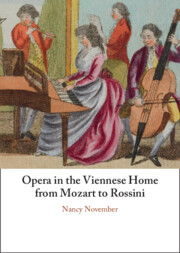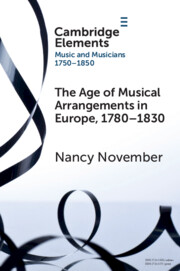95 results
6 - Industry, Agency, and Opera Arrangements in Czerny’s Vienna
-
- Book:
- Opera in the Viennese Home from Mozart to Rossini
- Published online:
- 18 February 2024
- Print publication:
- 18 January 2024, pp 182-230
-
- Chapter
- Export citation
Index
-
- Book:
- Opera in the Viennese Home from Mozart to Rossini
- Published online:
- 18 February 2024
- Print publication:
- 18 January 2024, pp 247-254
-
- Chapter
- Export citation
Copyright page
-
- Book:
- Opera in the Viennese Home from Mozart to Rossini
- Published online:
- 18 February 2024
- Print publication:
- 18 January 2024, pp iv-iv
-
- Chapter
- Export citation
1 - Opera in the ‘Fruitful Age of Musical Translations’
-
- Book:
- Opera in the Viennese Home from Mozart to Rossini
- Published online:
- 18 February 2024
- Print publication:
- 18 January 2024, pp 11-38
-
- Chapter
- Export citation
Figures
-
- Book:
- Opera in the Viennese Home from Mozart to Rossini
- Published online:
- 18 February 2024
- Print publication:
- 18 January 2024, pp vi-vii
-
- Chapter
- Export citation
4 - Canon Formation, Domestication, and Opera
-
- Book:
- Opera in the Viennese Home from Mozart to Rossini
- Published online:
- 18 February 2024
- Print publication:
- 18 January 2024, pp 103-136
-
- Chapter
- Export citation
Tables
-
- Book:
- Opera in the Viennese Home from Mozart to Rossini
- Published online:
- 18 February 2024
- Print publication:
- 18 January 2024, pp viii-ix
-
- Chapter
- Export citation
Musical Examples
-
- Book:
- Opera in the Viennese Home from Mozart to Rossini
- Published online:
- 18 February 2024
- Print publication:
- 18 January 2024, pp x-xi
-
- Chapter
- Export citation
2 - Kenner und Liebhaber
-
- Book:
- Opera in the Viennese Home from Mozart to Rossini
- Published online:
- 18 February 2024
- Print publication:
- 18 January 2024, pp 39-72
-
- Chapter
- Export citation
3 - Female Agency in the Early Nineteenth-Century Viennese Musical Salon
-
- Book:
- Opera in the Viennese Home from Mozart to Rossini
- Published online:
- 18 February 2024
- Print publication:
- 18 January 2024, pp 73-102
-
- Chapter
- Export citation
Acknowledgements
-
- Book:
- Opera in the Viennese Home from Mozart to Rossini
- Published online:
- 18 February 2024
- Print publication:
- 18 January 2024, pp xii-xii
-
- Chapter
- Export citation
Contents
-
- Book:
- Opera in the Viennese Home from Mozart to Rossini
- Published online:
- 18 February 2024
- Print publication:
- 18 January 2024, pp v-v
-
- Chapter
- Export citation
5 - Rossini ‘As the Viennese Liked It’
-
- Book:
- Opera in the Viennese Home from Mozart to Rossini
- Published online:
- 18 February 2024
- Print publication:
- 18 January 2024, pp 137-181
-
- Chapter
- Export citation
Bibliography
-
- Book:
- Opera in the Viennese Home from Mozart to Rossini
- Published online:
- 18 February 2024
- Print publication:
- 18 January 2024, pp 231-246
-
- Chapter
- Export citation

Opera in the Viennese Home from Mozart to Rossini
-
- Published online:
- 18 February 2024
- Print publication:
- 18 January 2024
Introduction
-
- Book:
- Opera in the Viennese Home from Mozart to Rossini
- Published online:
- 18 February 2024
- Print publication:
- 18 January 2024, pp 1-10
-
- Chapter
- Export citation

The Age of Musical Arrangements in Europe, 1780–1830
-
- Published online:
- 04 September 2023
- Print publication:
- 28 September 2023
-
- Element
- Export citation
6 - ‘Completely Absorbed by the Piano’
-
- Book:
- Beethoven's Symphonies Arranged for the Chamber
- Published online:
- 21 May 2021
- Print publication:
- 10 June 2021, pp 193-234
-
- Chapter
- Export citation
Frontmatter
-
- Book:
- Beethoven's Symphonies Arranged for the Chamber
- Published online:
- 21 May 2021
- Print publication:
- 10 June 2021, pp i-ii
-
- Chapter
- Export citation
Bibliography
-
- Book:
- Beethoven's Symphonies Arranged for the Chamber
- Published online:
- 21 May 2021
- Print publication:
- 10 June 2021, pp 239-250
-
- Chapter
- Export citation



